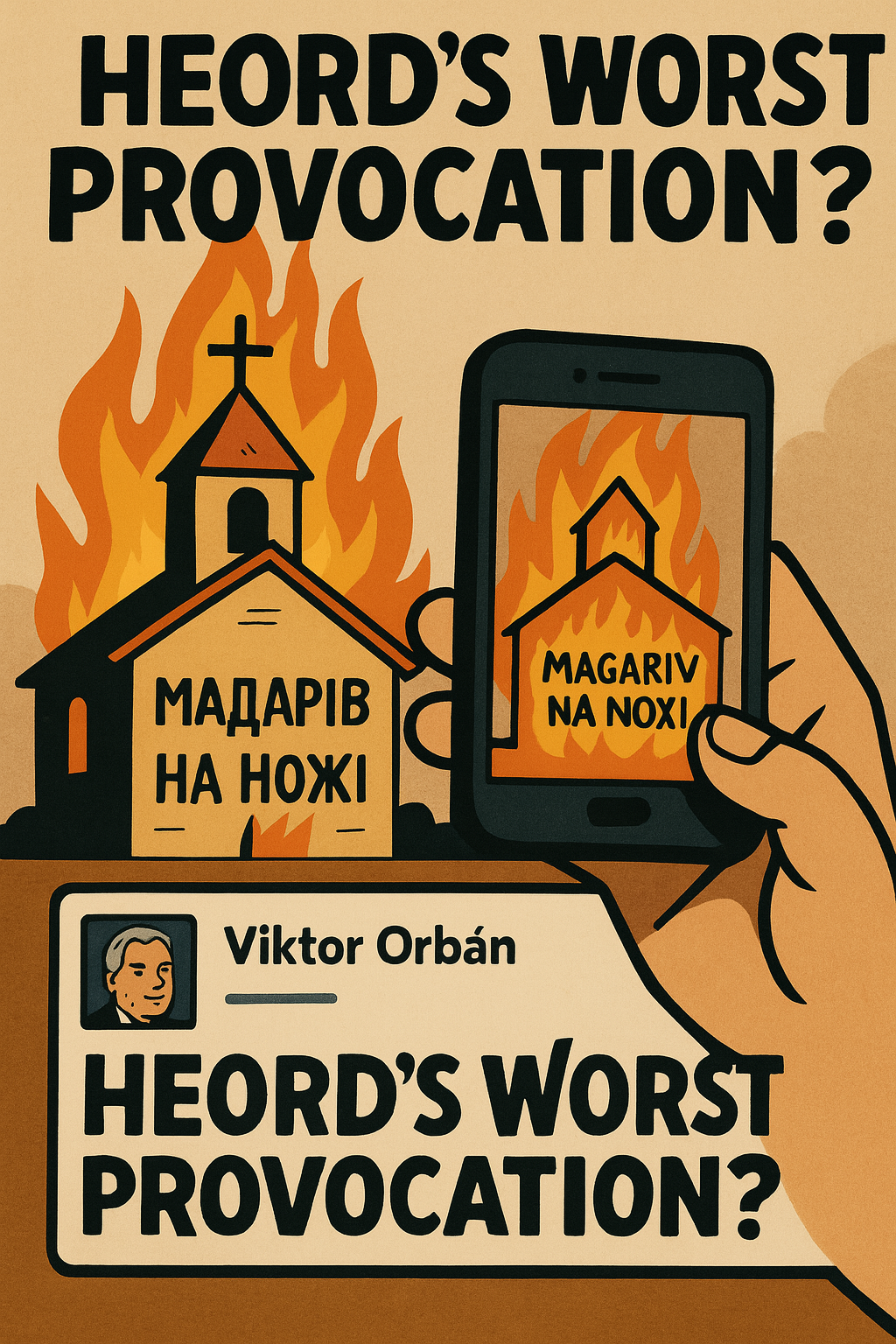Lately, the Hungarian press has been full of reports that the Ukrainian Security Service (SBU) and the Ukrainian police have arrested a 28-year-old local resident who, on the night of July 16, 2025, set fire to the Greek Catholic church in Palágykomoróc and wrote anti-Hungarian slogans on its wall.
Palágykomoróc (in Ukrainian: Паладь Комарівці) is a village in Ukraine, located in the Transcarpathian region, in the Uzhhorod district. János Butler, the main character of one of the most famous novels by Hungarian author Kálmán Mikszáth (1847–1910), A Strange Marriage, is buried here. The village is also the birthplace of János Orlay (1770–1829), a Hungarian-born surgeon who primarily worked in Russia, a liberal educator, polymath, and court physician of Tsar Alexander I.
At the 2001 census, Palágykomoróc had a population of 834, the majority (about 80%) belonging to the Hungarian minority in Ukraine, most of whom are Reformed. The remainder of the population is Ukrainian/Rusyn, typically Greek Catholic. A small number of Slovaks, Russians, and Roma also live in the village. The Slovak border lies close to the village, only 1 km from the Slovak village of Ruska (in Hungarian: Dobóruszka), which is also predominantly inhabited by Hungarians.

Regarding the arson attack, Russia expert András Rácz highlighted several suspicious circumstances in a Facebook post:
● Palágykomoróc is a very small village. Almost nothing ever happens there. Who was at the scene on Wednesday night and managed to take a photo before the border guards—who saw the fire—arrived running? Unless it was the perpetrator themselves…
● There is only one photo of the graffiti on the wall, which was immediately removed by those arriving at the scene. Why did the photographer send the image specifically to the Hungarian Prime Minister?
● The Hungarian government responded almost immediately—suspiciously quickly. Orbán posted the news on his Facebook at 9:35 the next morning as a fact. Are we really to take out a nighttime photo at face value that fast? The Prime Minister’s Facebook page is not run by him personally. He might still have been doing his morning routine when the image appeared. Why did the editor dare to post it before experts had assessed it? It gives the impression that someone knew in advance what was about to happen and that the photo was real. They were already waiting…
● The chosen target doesn’t make much sense. The village has two churches: one Reformed and one Greek Catholic. The majority of the Hungarian minority are Reformed. The Greek Catholic church is mostly attended by Rusyns and Ukrainians. The headline read, “A Hungarian church in Transcarpathia was set on fire”—but this isn’t “the Hungarian church.” A Hungarian Greek Catholic is about as common as a Black Russian. Why didn’t they target the church more frequented by Hungarians? A likely explanation is that 1) the arsonist didn’t know the difference between the two churches, or 2) the Greek Catholic church was more convenient because it’s on the edge of the village, while the Reformed church is in the center.
● The slogan on the wall: «МАДЯРIВ на НОЖI» (meaning “Hungarians to the knife”) is grammatically correct in Ukrainian but written in sloppy, childlike script. Curiously, the letters shared with the Latin alphabet are correct, while the Cyrillic letters (ДЯЖ) are poorly formed. Did the graffiti writer not know how to write in Ukrainian/Russian? Did they copy it from a slip of paper? From Google Translate or some propaganda template? Could the perpetrator not even be Ukrainian?

The fact that the SBU arrested a 28-year-old local doesn’t necessarily mean he acted alone. The question is whether he had someone behind him—was he instructed or controlled? Perpetrators in such cases are often useful idiots or financially motivated actors participating in operations planned by others.
Someone tried to imitate a Ukrainian extremist’s handwriting, but since they didn’t know the language, they blew it with the faulty letters. This is precisely the kind of blunder often made in false flag operations orchestrated by intelligence services—especially when the operative is just carrying out the task and doesn’t speak the local language well.
Russian propaganda has long employed false flag tactics—committing acts themselves while making it appear as though the other side did it. But it’s also possible the writing error was deliberate, so it could later be “exposed” as a provocation. That suggests a double game—and in that case, Orbán was played. It’s his decision how that fits into his agenda…
There are more questions than answers in this story. One thing is certain: the arson attack wasn’t just vandalism, but a deliberate political message—but from whom, and to whom, is still unclear.
PS: Dear Prime Minister! Dear Viktor! Now we’ve had a “beaten to death” drunkard and a burned church. Can’t you manage a proper provocation? I’ve told you already: the Fehérgyarmat–Penyige TV–FM trunk transmitter station should be attacked. It’s right next to the Ukrainian border. The script was written in August 1939—it’s called Operation Tannenberg, and it’s on Wikipedia.

